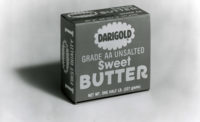We dusted off the jukebox to play the songs that best represent dairy foods and beverages. Our annual State of the Dairy Industry report examines the prospects for all dairy categories. Hit the play button on ‘Bread and Butter’ and see what’s happening in the butter category.
One result of the trend toward greater globalization in the dairy industry has been a narrowing of differences between dairy product prices in various countries. Certainly, domestic dairy policies here in the United States, and our willingness to enter into free trade agreements have resulted in a greater convergence of U.S. and world dairy market prices.
Therefore, it was unusual to see the situation being experienced in the butter markets this summer. In the spot (cash) market at the CME Group in Chicago, the wholesale price of butter rose to over $3.00 per pound, exceeding the previous record high of $2.81 set in 1998. Meanwhile, at the Global Dairy Trade exchange in New Zealand, butter prices fell to about $1.20 per pound. So, what is going on here?
First, let’s look at these markets and other dairy market price data. The CME Group provides a trading opportunity every week day for sellers and buyers to exchange loads of butter for delivery in the next few days. The reported price is a local price, meaning that if the sale occurs between a seller and buyer who are both on the West Coast, for example, the CME Group reported price is higher than the actual sale price due to a location adjustment.
The Global Dairy Trade (GDT) provides a trading opportunity every two weeks but not for immediate delivery. So one reason for the difference in prices is that the CME Group spot butter market is a price for butter delivered today, while the GDT butter price is an average for butter to be delivered over the next six or seven months.
Of course, there are other price series on butter available around the world. Several sources report butter prices in Europe, usually weekly, for local prices there. In the United States, the Agricultural Marketing Service (AMS) of the U.S. Department of Agriculture reports every two weeks on international market prices.
The role of trade barriers
Trade barriers still do exist. For example, the United States permits a limited quantity of butter to be imported every year while paying a low import tariff; this quantity is known as the tariff rate quota or TRQ, and the low import tariff is called the within-quota tariff. For quantities above that limit, a much higher import tariff, called the over-quota tariff, must be paid.
The over-quota tariff for butter to be imported into the United States is about 68 cents per pound, which is paid to the U.S. government, but there are other costs involved. The most obvious is the cost of transportation, followed by other costs like changes in packaging and labeling. So, unless the U.S. domestic butter price is more than 75 cents to 80 cents per pound higher than the world butter price, the United States is not an attractive market for butter imports.
How often is the U.S. butter price more than 80 cents above the world butter price? Not very often.
All butter is not created equal
So, now that we have reached, and far exceeded, that magic 80-cent difference between U.S. and world butter prices, why aren’t imports of butter flooding into the United States at prices below the CME Group spot market? There are several reasons.
First, unlike you or I, butter does not travel around the world on airplanes. It moves first by truck or train from a manufacturer or storage facility to a port and then by ship to the United States, and that takes time. Second, no foreign supplier wants to be caught with product on the water or at a U.S. port when prices quickly adjust back to more historical relationships.
Third, not all butter is created equal, and that is a very important point. In the United States, we mostly consume USDA Grade AA butter (which requires the product to contain at least 80% milkfat) and we like the salted variety. The rest of the world mostly consumes butter with a minimum of 82% milkfat and no salt.
So there is no butter that is 80% milkfat and salted just sitting around in warehouses waiting to be sent by truck, train and ship to the United States. Think of U.S. butter as a special order.
U.S. dairy exports soar
Clearly, one reason U.S. butter prices moved up this summer is that U.S. exports of butter and other dairy products soared in the first half of 2014. This meant more of the U.S. milk production was used to manufacture products for export customers. Most in the United States welcome that increased demand for our products.
But the U.S. dairy industry has a long history of building inventories of butter in the first half of every year when milk and cream tend to be more plentiful. Those inventories then are used to serve domestic demand later each year, especially in the fourth quarter for holiday baking and other events. We are now in a period when retailers and other domestic customers are looking for more product to meet expected demand next quarter, and they’re willing to pay to make sure that product is available.
So, while the rest of the world is seeing lower butter prices, the United States is dealing with lower butter inventories heading into peak demand season. However, U.S. markets appear to expect that domestic demand will ease over the next few months and/or supplies of butter will grow due to greater domestic production or lower U.S. dairy exports. It’s also possible that foreign butter will start to show up here.








